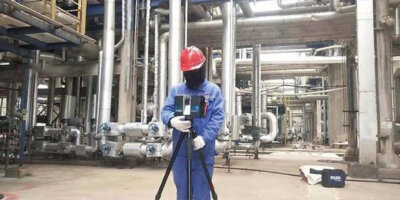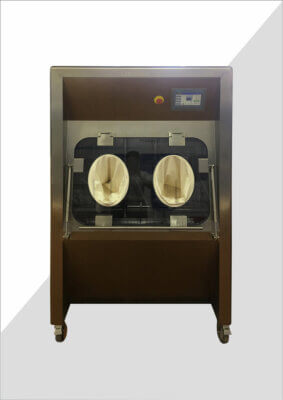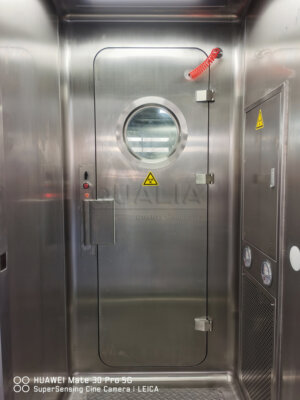In the world of scientific research and biomedical facilities, safety is paramount. One crucial aspect of this safety protocol involves the proper handling and disposal of potentially hazardous liquid waste. This is where effluent decontamination systems come into play, serving as a critical line of defense against the spread of dangerous pathogens and other biological agents.
Effluent decontamination systems are specialized equipment designed to inactivate or sterilize liquid wastes produced in laboratories and other facilities handling biohazardous materials. These systems are particularly important in high-containment environments such as Biosafety Level 3 (BSL-3) and Biosafety Level 4 (BSL-4) laboratories, where researchers work with some of the most dangerous pathogens known to humanity.
As we delve deeper into this topic, we'll explore the types of laboratories that require these systems, how they function, and why they are so crucial in maintaining biosafety standards. We'll also examine the regulatory requirements surrounding effluent decontamination and the latest technological advancements in this field.
Effluent decontamination systems are mandatory for BSL-3 and BSL-4 laboratories to ensure the safe handling and disposal of potentially infectious liquid waste, preventing the release of dangerous pathogens into the environment.
Before we dive into the specifics, let's take a look at an overview of biosafety levels and their corresponding effluent decontamination requirements:
| Biosafety Level | Risk Level | Effluent Decontamination Requirement |
|---|---|---|
| BSL-1 | Minimal risk | Not typically required |
| BSL-2 | Moderate risk | Recommended but not always mandatory |
| BSL-3 | High risk | Mandatory |
| BSL-4 | Extreme risk | Mandatory with additional safeguards |
Now, let's explore the various aspects of effluent decontamination systems in more detail.
Which laboratories are required to have effluent decontamination systems?
When it comes to biosafety, not all laboratories are created equal. The level of containment required depends on the nature of the work being conducted and the potential risks associated with the biological agents being handled.
Biosafety Level 3 (BSL-3) and Biosafety Level 4 (BSL-4) laboratories are at the forefront of research involving highly infectious agents and potentially lethal diseases. These facilities are required by law to have effluent decontamination systems in place.
BSL-3 and BSL-4 laboratories must be equipped with effluent decontamination systems to prevent the accidental release of dangerous pathogens into the environment through liquid waste streams.
| Laboratory Type | Examples of Pathogens Handled | Effluent Decontamination Requirement |
|---|---|---|
| BSL-3 | Tuberculosis, West Nile virus | Mandatory |
| BSL-4 | Ebola, Marburg virus | Mandatory with additional safeguards |
How do effluent decontamination systems work?
Effluent decontamination systems employ a combination of physical and chemical processes to render biohazardous liquid waste safe for disposal. These systems are designed to handle a wide range of potential contaminants, from bacteria and viruses to fungi and parasites.
The most common method used in effluent decontamination systems is thermal treatment, which involves heating the liquid waste to high temperatures under pressure. This process, known as autoclaving, effectively destroys microorganisms by denaturing their proteins and disrupting their cellular structures.
Effluent decontamination systems typically use a combination of heat and pressure to achieve a minimum temperature of 121°C (250°F) for at least 30 minutes, ensuring the complete inactivation of biological agents in liquid waste.
| Treatment Method | Temperature | Pressure | Duration |
|---|---|---|---|
| Autoclaving | 121°C (250°F) | 15 psi | 30-60 minutes |
| Chemical Treatment | Varies | Atmospheric | Varies |
Why are effluent decontamination systems crucial for biosafety?
The importance of effluent decontamination systems in maintaining biosafety cannot be overstated. These systems serve as a critical barrier between potentially hazardous biological agents and the outside environment, preventing the accidental release of dangerous pathogens through liquid waste streams.
Without proper decontamination, liquid waste from high-containment laboratories could pose a significant risk to public health and the environment. Effluent decontamination systems ensure that any microorganisms present in the waste are effectively inactivated before the liquid is released into the sewage system or other disposal channels.
Effluent decontamination systems are essential for preventing the spread of infectious diseases and protecting both laboratory personnel and the general public from potential exposure to hazardous biological agents.
| Biosafety Measure | Purpose | Importance |
|---|---|---|
| Effluent Decontamination | Inactivate biological agents in liquid waste | Critical |
| Personal Protective Equipment | Protect laboratory personnel | Essential |
| Air Filtration | Prevent airborne contamination | Crucial |
What are the regulatory requirements for effluent decontamination?
The use of effluent decontamination systems is governed by various regulatory bodies and guidelines, including those set forth by the Centers for Disease Control and Prevention (CDC), the World Health Organization (WHO), and the National Institutes of Health (NIH).
These regulations stipulate that BSL-3 and BSL-4 laboratories must have validated effluent decontamination systems in place. The systems must be regularly tested and maintained to ensure their effectiveness in inactivating biological agents.
Regulatory bodies require that effluent decontamination systems in BSL-3 and BSL-4 laboratories be validated through rigorous testing, including the use of biological indicators to confirm the complete inactivation of microorganisms.
| Regulatory Body | Guideline Document | Key Requirements |
|---|---|---|
| CDC | Biosafety in Microbiological and Biomedical Laboratories (BMBL) | Mandatory effluent decontamination for BSL-3 and BSL-4 |
| WHO | Laboratory Biosafety Manual | Detailed specifications for effluent treatment |
| NIH | NIH Guidelines for Research Involving Recombinant or Synthetic Nucleic Acid Molecules | Specific requirements for facilities handling recombinant DNA |
What are the latest advancements in effluent decontamination technology?
The field of effluent decontamination is continually evolving, with new technologies and methods being developed to improve efficiency, reliability, and safety. One notable advancement is the development of continuous flow systems, which offer several advantages over traditional batch processing methods.
QUALIA has been at the forefront of these innovations, developing state-of-the-art effluent decontamination systems that incorporate the latest technological advancements.
Continuous flow effluent decontamination systems offer improved efficiency and capacity compared to batch systems, allowing for the treatment of larger volumes of liquid waste without interruption to laboratory operations.
| System Type | Advantages | Disadvantages |
|---|---|---|
| Batch Processing | Simpler design, lower initial cost | Limited capacity, potential workflow interruptions |
| Continuous Flow | Higher capacity, improved efficiency | More complex design, higher initial cost |
How are effluent decontamination systems validated and maintained?
Ensuring the ongoing effectiveness of effluent decontamination systems is crucial for maintaining biosafety standards. Regular validation and maintenance procedures are essential to confirm that these systems are functioning as intended and consistently inactivating biological agents in liquid waste.
Validation typically involves the use of biological indicators, which are standardized preparations of highly resistant bacterial spores. These indicators are subjected to the decontamination process, and their survival or inactivation serves as a measure of the system's effectiveness.
Effluent decontamination systems must undergo regular validation testing, including the use of Geobacillus stearothermophilus spores as biological indicators, to ensure their continued effectiveness in inactivating a wide range of microorganisms.
| Validation Method | Frequency | Purpose |
|---|---|---|
| Biological Indicators | Monthly or quarterly | Confirm inactivation of resistant microorganisms |
| Physical Parameters | Continuous monitoring | Ensure proper temperature, pressure, and duration |
| Chemical Indicators | Each cycle | Visual confirmation of process conditions |
What are the environmental considerations for effluent decontamination?
While the primary purpose of effluent decontamination systems is to protect public health and safety, it's also important to consider their environmental impact. The high temperatures and pressures used in these systems require significant energy input, and the chemicals used in some decontamination processes may have environmental implications.
As a result, there is growing interest in developing more sustainable effluent decontamination methods that balance effective pathogen inactivation with reduced environmental impact. This includes exploring alternative technologies such as advanced oxidation processes and membrane filtration systems.
Emerging effluent decontamination technologies aim to reduce energy consumption and minimize the use of potentially harmful chemicals while maintaining or improving the effectiveness of pathogen inactivation.
| Decontamination Method | Energy Consumption | Chemical Usage | Environmental Impact |
|---|---|---|---|
| Traditional Autoclaving | High | Low | Moderate |
| Chemical Treatment | Low | High | Potentially high |
| Advanced Oxidation | Moderate | Moderate | Lower |
In conclusion, effluent decontamination systems play a vital role in ensuring the safe operation of high-containment laboratories and protecting public health. These systems are mandatory for BSL-3 and BSL-4 facilities, where researchers work with some of the most dangerous pathogens known to humanity. By effectively inactivating biological agents in liquid waste, effluent decontamination systems prevent the accidental release of hazardous materials into the environment.
As technology continues to advance, we can expect to see further improvements in the efficiency, reliability, and sustainability of effluent decontamination systems. These advancements will help to enhance biosafety measures while minimizing environmental impact, ensuring that scientific research can continue to progress safely and responsibly.
The importance of proper effluent decontamination cannot be overstated in our increasingly interconnected world, where the potential for disease outbreaks remains a constant concern. By investing in robust biosafety measures, including state-of-the-art effluent decontamination systems, we can continue to push the boundaries of scientific knowledge while safeguarding public health and the environment.
External Resources
Effluent Decontamination System – Treatment of Bio Contaminants – This resource explains that effluent decontamination systems are required by law for facilities classified as biosafety level 3 and 4. It details how these systems use a combination of heat and pressure to destroy microorganisms in effluent.
Effluent Decontamination System | Biowaste Hazardous Waste – Suncombe's page discusses the use of effluent decontamination systems in various facilities, including research, production, and bio-containment environments. It highlights the effectiveness of these systems in sterilizing or inactivating harmful pathogens.
Effluent decontamination system – This Wikipedia article provides a comprehensive overview of effluent decontamination systems, including their use in hospitals, laboratories, and other facilities. It details both batch and continuous flow systems and the methods they employ.
The Design and Testing of a Continuous Effluent Sterilization System of Liquid Waste – This report discusses the design and testing of a continuous effluent sterilization system, particularly relevant for Biosafety Level 3 and 4 laboratories. It highlights the benefits and considerations of using continuous processes over traditional batch-based methods.
Decontamination vs. Inactivation – Although primarily focused on decontamination and inactivation methods, this document mentions effluent decontamination systems as part of the broader context of managing biohazardous materials, including liquid wastes from biocontainment laboratories.
Biosafety in Microbiological and Biomedical Laboratories (BMBL) – Waste Management – This CDC resource provides guidelines on waste management, including the requirement for effluent decontamination systems in laboratories handling biohazardous materials, especially at higher biosafety levels.
Related Contents:
- Effluent Decontamination: Essential for High-Risk Labs
- Continuous Effluent Decontamination: Protecting Our Environment
- Effluent Decontamination Systems for Biosafety Laboratories
- Thermal Effluent Decontamination: Protecting Our Environment
- Effluent Decontamination Systems: Safeguarding Malaysia’s Environment
- The ACTINI Effluent Decontamination System: Safeguarding Biohazardous Waste
- Effluent Decontamination: Safeguarding Our Environment
- Decontamination Systems: Safeguarding Health and Environment
- Water Decontamination: Essential Methods for Clean, Safe Water






























